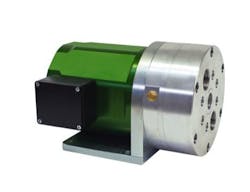Turbine Generator Captures and Re-uses Wasted Energy
June 27, 2011
3 min read
Efforts to harvest energy typically lost during production operations
are increasingly becoming a key facet of sustainability projects at a
number of industrial facilities worldwide. Many of these projects focus
on energizing low-power devices, such as sensors, through capture of
wasted energy from vibrations or heat dissipation. While these projects
are intriguing and admirable, significant amounts of energy released by
industrial systems remains untapped for regenerative purposes or for
companies to sell back to power utilities as a means of offsetting
energy costs or generating revenues.
In an attempt to address this issue, the German Federal Ministry of
Economics and Technology is funding a project at Deprag Schulz GmbH
& Co.(www.deprag.com) to capture excess process gas for energy generation. Of
course, energy recovery from excess process gas in not a new idea, but
this project at Deprag Schulz differs from other such energy capture
applications in that it involves converting small amounts of residual
energy (5 -20 kilowatts) directly into electricity using a small
generator.
When Deprag Schulz embarked on this project, engineers at the company
could not find a standard generator small enough or that employed
suitable materials for use as the core of this new energy generation
device. To be effective in this application, Deprag Schulz engineers
calculated that the rotational speed of the generator would need to be
around 40,000 rpm. This realization led the engineers to design an
electric turbine generator based on a permanent magnet synchronous
induction machine for the generation of electricity.
The prototype from Deprag Schulz is a compact unit made from a
microexpansion turbine with an electrical generator that produces
electricity from gas. The core turbine generator unit, not including the
electrical control box, is not much bigger than a shoebox and can be
used locally where gas is either released unused by the industrial
process or where a high level of pressure is reduced to a lower value.
Here’s how the turbine generator works: Gas flows into the turbine and
is pressed through jets to accelerate its movement. When it meets the
blades of the turbine and is diverted, it releases energy. This kinetic
energy is then converted to electrical energy in the generator.
The key to the design of this prototype is that the turbine and electric
generator have one shared drive shaft. This means that, when the
turbine rotates, so does the generator’s rotor, enabling electrical
energy to be generated.
To help visualize how such a turbine generator could be applied in an
industrial setting, consider the tanks used in the smelting of metals.
These tanks are typically cooled by compressed air. The compressed air
flows through cooling channels and absorbs heat. Typically, this air is
then released into the atmosphere without being used. With the turbine
generator, the energy absorbed from the heat can be converted into
electricity by passing it through the microexpansion turbine and the
integrated generator and then feeding the resulting power back into the
grid.Deprag Schulzwww.deprag.com
About the Author
David Greenfield, editor in chief
Editor in Chief
David Greenfield joined Automation World in June 2011. Bringing a wealth of industry knowledge and media experience to his position, David’s contributions can be found in AW’s print and online editions and custom projects. Earlier in his career, David was Editorial Director of Design News at UBM Electronics, and prior to joining UBM, he was Editorial Director of Control Engineering at Reed Business Information, where he also worked on Manufacturing Business Technology as Publisher.
Sign up for our eNewsletters
Get the latest news and updates

Leaders relevant to this article:
